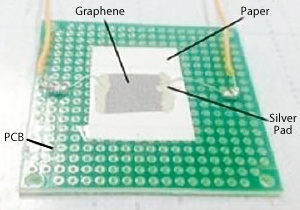| Sep 12, 2011 |
Graphene rocks
|
|
(Nanowerk News) Since it was first isolated and characterized less than a decade ago, graphene has taken the world of materials science by storm. It is already known that graphene has remarkable electrical properties and can transfer heat better than any other material. Now, Tian-Ling Ren and colleagues from Tsinghua University in China have shown that graphene can also produce sound ("Graphene-on-Paper Sound Source Devices").
|
|
The researchers have demonstrated that graphene's ability to heat up and cool down extremely quickly makes it the perfect 'thermoacoustic' transducer, allowing them to prepare what may be the thinnest speaker in the world — a sheet of graphene just a single atom thick.
|
 |
| The graphene-based thermoacoustic 'speaker'. (© 2011 ACS)
|
|
The team's 'thermophone' is made of a small square of graphene film fixed to a piece of paper and mounted on a printed circuit board (see image). Applying an electrical current via silver ink contacts on the graphene sheet, the material heats up rapidly, causing the air in contact with the sheet to heat up and expand. When the electrical current is varied like an acoustic signal, this rapid air heating effect produces audible sound.
|
|
The scientists tested graphene sheets of up to five atomic layers thick, and found that the thinnest, just 20 nm thick, was most efficient at producing sound because of its low heat capacity.
|
|
Other researchers at Tsinghua University have previously demonstrated sound production using a similar thermophone made from a sheet of carbon nanotubes. That freestanding sheet, however, projected sound in all directions, whereas the paper backing of the graphene thermophone prevents sound from being emitted from the paper side.
|
|
Using an infrared camera to monitor the thermal cycling of the graphene thermophone, the researchers found that a power input of just 0.16 W was sufficient to heat the air next to the sheet to almost 50 °C and confirmed that the thermoacoustic effect was responsible for the sound. The graphene thermophone can also produce ultrasound, and reaches its peak efficiency at an inaudible 32 kHz.
|
|
The team suggests that because their device is simple, inexpensive, transparent and does not actually vibrate when operating, it could be used in a variety of applications from speakers and earphones to ultrasound imaging.
|

